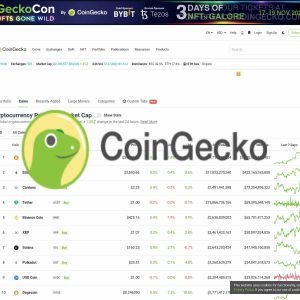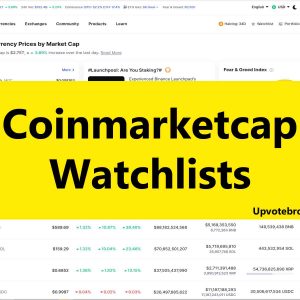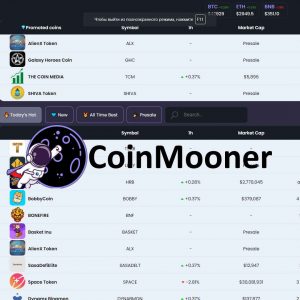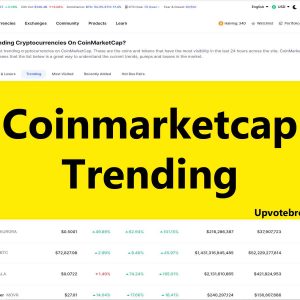Cryptocurrency tokens are digital assets that operate on a blockchain network and have various use cases, such as payments, rewards, governance, or utility. Unlike crypto coins, which have their own native blockchains, tokens are built on top of existing platforms, such as Ethereum, Binance Smart Chain (BSC), Solana, or Polygon. This makes creating a token easier and faster than creating a coin, as you don’t need to code your own blockchain from scratch.

However, creating a token still requires some technical knowledge and resources, as well as a clear vision and purpose for your project. In this article, we will explain how to create a cryptocurrency token in nine steps, from researching your idea to launching your token to the public.
-
Product on sale
 Buy Coinmarketcap followers to account$2.00 – $500.00
Buy Coinmarketcap followers to account$2.00 – $500.00 -
 Boost Coingecko Trending$1,200.00 – $1,600.00
Boost Coingecko Trending$1,200.00 – $1,600.00 -
Product on sale
 Buy Coingecko Watchlists$3.00 – $1,900.00
Buy Coingecko Watchlists$3.00 – $1,900.00 -
Product on sale
 Buy Coinmarketcap watchlist$2.00 – $490.00
Buy Coinmarketcap watchlist$2.00 – $490.00 -
Product on sale
 Buy Coinmooner upvotes$2.00 – $1,200.00
Buy Coinmooner upvotes$2.00 – $1,200.00 -
Product on sale
 Buy Coinmarketcap Trending$1,500.00 – $5,900.00
Buy Coinmarketcap Trending$1,500.00 – $5,900.00
What is a Cryptocurrency Token?
A cryptocurrency token is a type of digital asset that represents some value or functionality on a blockchain network. Tokens can be used for various purposes, such as:
- Payments: Tokens can be used as a medium of exchange for goods and services, both online and offline. For example, Bitcoin Cash (BCH) is a token that aims to facilitate fast and cheap transactions for everyday use.
- Rewards: Tokens can be used as an incentive mechanism for users to participate in a network or platform. For example, Basic Attention Token (BAT) is a token that rewards users for viewing ads and content on the Brave browser.
- Governance: Tokens can be used as a way to give users voting rights and influence over the decisions and direction of a project. For example, Maker (MKR) is a token that allows holders to vote on the parameters and policies of the MakerDAO protocol.
- Utility: Tokens can be used as a way to access or provide certain services or functions on a platform. For example, Chainlink (LINK) is a token that enables smart contracts to connect with real-world data and events.
There are different types of tokens based on the standards and protocols they follow. The most common ones are:
- ERC-20: This is the most widely used token standard on the Ethereum network. It defines a set of rules and functions for creating and interacting with tokens. Most of the tokens on Ethereum are ERC-20 compliant, such as USDT, UNI, and LINK.
- BEP-20: This is a token standard on the Binance Smart Chain network. It is similar to ERC-20, but with some differences and optimizations. It allows for cross-chain compatibility with other blockchains that support the same standard, such as Ethereum. Some examples of BEP-20 tokens are BNB, CAKE, and BUSD.
- SPL: This is a token standard on the Solana network. It is designed to be fast, scalable, and low-cost. It supports various features, such as fungibility, divisibility, and decimals. Some examples of SPL tokens are SOL, SRM, and RAY.
- ERC-721: This is a token standard on the Ethereum network that supports non-fungible tokens (NFTs). NFTs are unique and indivisible tokens that represent digital or physical assets, such as art, music, or collectibles. Some examples of ERC-721 tokens are CryptoKitties, CryptoPunks, and Axie Infinity.
Step-by-Step Guide to Creating a Token
Creating a token can be a complex and challenging process, but it can also be rewarding and fulfilling if you have a clear vision and purpose for your project. Here are the steps you need to follow to create a token:
1. Research
The first step is to research your idea and market. You need to answer some questions, such as:
- What problem are you trying to solve with your token?
- What value proposition and utility does your token offer?
- Who are your target audience and potential users?
- What are the existing competitors and alternatives in your niche?
- How will you differentiate your token from others?
You also need to research the technical aspects of creating a token, such as:
- What blockchain platform will you use to create your token?
- What token standard and protocol will you follow?
- What tools and resources will you need to create and deploy your token?
- What skills and expertise will you need to create and maintain your token?
2. Decide on the Technical Specifications
The next step is to decide on the technical specifications of your token, such as:
- Name: This is the name of your token, such as Bitcoin or Ethereum. It should be catchy, memorable, and relevant to your project.
- Symbol: This is the abbreviation or ticker of your token, such as BTC or ETH. It should be short, unique, and easy to recognize.
- Decimals: This is the number of decimal places your token can be divided into, such as 18 for ETH or 8 for BTC. It should be appropriate for your use case and market.
- Supply: This is the total number of tokens that will ever exist, such as 21 million for BTC or unlimited for ETH. It should be determined by your tokenomics and demand.
- Distribution: This is the way you will allocate and distribute your tokens to various stakeholders, such as developers, investors, users, or partners. It should be fair, transparent, and aligned with your goals.
3. Choose a Blockchain Platform
The third step is to choose a blockchain platform to create your token. There are many platforms available, each with its own advantages and disadvantages. Some of the factors you need to consider are:
- Compatibility: The platform should support the token standard and protocol you want to use, such as ERC-20, BEP-20, or SPL.
- Scalability: The platform should be able to handle high volumes of transactions and users without compromising speed or security.
- Cost: The platform should have low fees and gas costs for creating and transferring tokens.
- Community: The platform should have a large and active community of developers and users who can support and promote your project.
Some of the most popular platforms for creating tokens are:
- Ethereum: This is the largest and most established platform for creating tokens. It supports various token standards, such as ERC-20, ERC-721, and ERC-1155. It also has a rich ecosystem of tools, resources, and applications, such as Solidity, Remix, Truffle, OpenZeppelin, MetaMask, Uniswap, and more. However, Ethereum also has some drawbacks, such as high fees, congestion, and scalability issues.
- Binance Smart Chain: This is a fast-growing platform for creating tokens. It supports the BEP-20 token standard, which is compatible with ERC-20. It also has a vibrant ecosystem of tools, resources, and applications, such as BSCScan, PancakeSwap, BakerySwap, Venus, and more. Moreover, Binance Smart Chain has low fees, high speed, and cross-chain interoperability with other blockchains. However, Binance Smart Chain also has some drawbacks, such as centralization, security, and regulation risks.
- Solana: This is a high-performance platform for creating tokens. It supports the SPL token standard, which is fast, scalable, and low-cost. It also has a growing ecosystem of tools, resources, and applications, such as Solana Explorer, Sollet, Serum, Raydium, and more. However, Solana also has some drawbacks, such as complexity, instability, and competition.
4. Create a Whitepaper
The fourth step is to create a whitepaper for your token. A whitepaper is a document that describes the vision, goals, features, and details of your project. It should include information such as:
- Introduction: This is the overview of your project, including the problem statement, solution, value proposition, and use cases of your token.
- Tokenomics: This is the economic model of your token, including the supply, distribution, allocation, and incentives of your token.
- Roadmap: This is the timeline of your project, including the milestones, deliverables, and achievements of your project.
- Team: This is the introduction of your team members, including their roles, backgrounds, and expertise.
- Legal: This is the disclaimer of your project, including the risks, limitations, and regulations of your project.
A whitepaper is an important tool to communicate your idea and vision to potential investors, partners, and users. It should be clear, concise, and professional.
5. Create a Token Contract
The fifth step is to create a token contract for your token. A token contract is a piece of code that defines the rules and functions of your token. It should follow the token standard and protocol you have chosen in step 2.
To create a token contract, you need to use a programming language that is compatible with your chosen platform. For example:
- If you want to create an ERC-20 token on Ethereum, you need to use Solidity, which is a smart contract language for Ethereum.
- If you want to create a BEP-20 token on Binance Smart Chain, you can also use Solidity, as Binance Smart Chain is compatible with Ethereum.
- If you want to create an SPL token on Solana, you need to use Rust or C++, which are programming languages for Solana.
You can either write your own code from scratch or use existing templates or libraries that provide ready-made code for creating tokens. For example:
- If you want to create an ERC-20 token on Ethereum, you can use OpenZeppelin, which is a library of secure and audited smart contract code for ERC-20 tokens.
- If you want to create a BEP-20 token on Binance Smart Chain, you can use Token Tool, which is a web-based tool that allows you to create and deploy BEP-20 tokens without coding.
- If you want to create an SPL token on Solana, you can use SPL Token UI, which is a web-based tool that allows you to create and manage SPL tokens with a few clicks.
To deploy your token contract, you need to use a wallet that is compatible with your chosen platform. For example:
- If you want to deploy an ERC-20 token on Ethereum, you need to use MetaMask, which is a browser extension that allows you to interact with Ethereum smart contracts and dApps.
- If you want to deploy a BEP-20 token on Binance Smart Chain, you need to use Trust Wallet, which is a mobile app that allows you to interact with Binance Smart Chain smart contracts and dApps.
- If you want to deploy an SPL token on Solana, you need to use Sollet, which is a web-based wallet that allows you to interact with Solana smart contracts and dApps.
You also need to pay some fees or gas costs for deploying your token contract. These fees vary depending on the platform, the network congestion, and the complexity of your code. For example:
- On Ethereum, the average fee for deploying an ERC-20 token contract is around $100-$200 at the time of writing.
- On Binance Smart Chain, the average fee for deploying a BEP-20 token contract is around $1-$2 at the time of writing.
- On Solana, the average fee for deploying an SPL token contract is around $0.01-$0.02 at the time of writing.
6. Develop a Token Wallet
The sixth step is to develop a token wallet for your token. A token wallet is a software application that allows users to store, send, and receive your token. It should be user-friendly, secure, and compatible with your token standard and protocol.
You can either develop your own token wallet from scratch or use existing wallet solutions that support your token. For example:
- If you have created an ERC-20 token on Ethereum, you can use MetaMask, Trust Wallet, Coinbase Wallet, or any other wallet that supports ERC-20 tokens.
- If you have created a BEP-20 token on Binance Smart Chain, you can use Trust Wallet, MetaMask, Binance Chain Wallet, or any other wallet that supports BEP-20 tokens.
- If you have created an SPL token on Solana, you can use Sollet, Phantom, Solflare, or any other wallet that supports SPL tokens.
You can also integrate your token wallet with your website or app, so that users can easily access and use your token. For example:
- If you have a website or app that allows users to buy, sell, or trade your token, you can integrate your token wallet with a web3 provider, such as MetaMask or WalletConnect, which allows users to connect their wallets to your website or app.
- If you have a website or app that allows users to access or provide certain services or functions with your token, you can integrate your token wallet with a smart contract interface, such as Web3.js or Ethers.js, which allows users to interact with your token contract from your website or app.
7. Test Your Token
The seventh step is to test your token before launching it to the public. Testing your token is crucial to ensure that it works as intended and that there are no bugs, errors, or vulnerabilities in your code.
You can test your token in various ways, such as:
- Using testnets: Testnets are simulated blockchain networks that allow you to test your token without using real money or affecting the mainnet. Most platforms have their own testnets, such as Ethereum’s Ropsten, Rinkeby, and Kovan; Binance Smart Chain’s Testnet; and Solana’s Devnet and Testnet. You can deploy your token contract to a testnet and use fake tokens to test its functionality and performance.
- Using debuggers: Debuggers are tools that allow you to inspect and modify your code while it is running. They can help you identify and fix any errors or issues in your code. Some examples of debuggers are Remix for Ethereum and Solana Explorer for Solana.
- Using auditors: Auditors are experts who review and verify your code for any security, quality, or compliance issues. They can help you ensure that your code is safe, reliable, and compliant with the best practices and standards. Some examples of auditors are CertiK, Quantstamp, and ConsenSys Diligence.
8. Launch Your Token
The eighth step is to launch your token to the public. Launching your token means making it available and accessible to potential users, investors, and partners. There are different ways to launch your token, such as:
- Airdropping: Airdropping is a method of distributing your token for free to a selected group of recipients, such as early supporters, community members, or newsletter subscribers. It can help you generate awareness, interest, and loyalty for your token.
- Listing: Listing is a method of making your token available for trading on a crypto exchange or platform, such as Coinbase, Binance, Uniswap, or PancakeSwap. It can help you increase the liquidity, visibility, and value of your token.
- Marketing: Marketing is a method of promoting your token to a wider audience, such as potential users, investors, and partners. It can help you communicate your vision, goals, and features of your token and attract more attention and support for your project.
9. Launch an Initial Coin Offering (ICO)
The ninth step is to launch an initial coin offering (ICO) for your token. An ICO is a type of crowdfunding campaign that allows you to raise funds for your project by selling your token to the public. It can help you finance the development, operation, and growth of your project.
However, launching an ICO also involves some risks and challenges, such as:
- Regulation: ICOs are subject to various laws and regulations in different jurisdictions, such as securities laws, anti-money laundering laws, and consumer protection laws. You need to comply with all the relevant rules and requirements in the countries where you plan to conduct your ICO.
- Competition: ICOs are highly competitive and saturated in the crypto space. You need to stand out from the crowd and convince potential investors that your token is worth buying.
- Scams: ICOs are prone to scams and frauds by malicious actors who may try to deceive or exploit investors or users. You need to protect yourself and your project from any potential threats or attacks.
10. List Your Token on CoinMarketCap
The tenth step is to list your token on CoinMarketCap (CMC), the most popular website for tracking cryptocurrency market capitalization and rankings. Listing your token on CMC can increase your visibility, credibility, and trading volume, as well as attract more users, investors, and partners to your project.
However, listing your token on CMC also involves some requirements and challenges, such as:
- Qualification: Your token must meet the minimum criteria for listing on CMC, such as having a functional website, a whitepaper, a public team, a block explorer, and at least one exchange listing with non-trivial trading volume.
- Application: You must fill out and submit the online request form for adding a new crypto asset to CMC. You must provide accurate and complete information about your project and token, as well as supporting evidence and documentation.
- Verification: CMC will review and verify your request based on their data admissibility guidelines and listings criteria. They will check the credibility, verification, and methodology of your request and may ask for additional information or clarification if needed.
- Approval: CMC will notify you via email if your request is approved or rejected. If approved, your token will be added to CMC within a few days. If rejected, you can reapply after addressing the issues or feedback provided by CMC.
To list your token on CoinMarketCap, you need to follow these steps:
- Go to https://support.coinmarketcap.com/hc/en-us/requests/new
- Select “1 – [New Listing] Add cryptoasset” from the drop-down menu
- Enter your official project’s email address
- In the “Subject Field (Please adhere to the format)” write your info in this format: [Token Name] – [Token Symbol] – [Add cryptoasset]
- Fill in all the rest fields with accurate and complete information about your project and token
- Attach any relevant files or documents that support your request
- Click the “Submit” button
You can check the status of your request by logging in to your account and viewing your tickets. You can also contact CMC via email or Telegram if you have any questions or issues.
Conclusion
Creating your own cryptocurrency token is a complicated process that requires a lot of research, planning, development, testing, and marketing. However, it can also be a rewarding and fulfilling experience if you have a clear vision and purpose for your project and a passionate and dedicated team to support you.
In this article, we have explained how to create a cryptocurrency token in nine steps, from researching your idea to launching your token to the public. We hope this article has given you some insights and guidance on how to create your own cryptocurrency token. Good luck!

